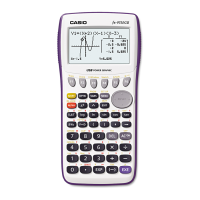2-24
I Differential Calculations [OPTN]-[CALC]-[d/dx]
To perform differential calculations, first display the function analysis menu, and then input the
values using the syntax below.
*(CALC)* (
d/dx) f(x)atol * fx-7400GII: (CALC)
(
a: point for which you want to determine the derivative, tol: tolerance)
The differentiation for this type of calculation is defined as:
In this definition, infinitesimal is replaced by a sufficiently small
x, with the value in the
neighborhood of f
'
(a) calculated as:
In order to provide the best precision possible, this unit employs central difference to perform
differential calculations.
Example To determine the derivative at point
x = 3 for the function
y = x
3
+4x
2
+ x – 6, with a tolerance of “tol”=1E –5
Input the function f(x).
*(CALC)* (
d/dx)T,BCTVTE
* fx-7400G
II: (CALC)
Input point
x = a for which you want to determine the derivative.
B
Input the tolerance value.
@$DU
Using Differential Calculation in a Graph Function
• Omitting the tolerance (tol) value when using the differential command inside of a graph
function simplifies the calculation for drawing the graph. In such a case, precision is
sacrificed for the sake of faster drawing. The tolerance value is specified, the graph is drawn
with the same precision obtained when you normally perform a differential calculation.
• You can also omit input of the derivative point by using the following format for the differential
graph:Y2=
d/dx(Y1). In this case, the value of the X variable is used as the derivative point.
Differential Calculation Precautions
• In the function f(x), only X can be used as a variable in expressions. Other variables
(A through Z excluding X, r, Ƨ) are treated as constants, and the value currently assigned to
that variable is applied during the calculation.
• Input of the tolerance (
tol) value and the closing parenthesis can be omitted. If you omit
tolerance (tol) value, the calculator automatically uses a value for tol as 1E–10.
• Specify a tolerance (
tol) value of 1E–14 or greater. An error (Time Out) occurs whenever no
solution that satisfies the tolerance value can be obtained.
• Pressing during calculation of a differential (while the cursor is not shown on the display)
interrupts the calculation.
d
/
dx
(
f
(
x
)
,
a
)
f
(
a
)
dx
d
d
/
dx
(
f
(
x
)
,
a
)
f
(
a
)
dx
d
f
(
a
+
A
x
)–
f
(
a
)
f
(
a
) = lim
–––––––––––––
A
x
A
x
0
'
f
(
a
+
A
x
)–
f
(
a
)
f
(
a
) = lim
–––––––––––––
A
x
A
x
0
'
f
(
a
+
A
x
)–
f
(
a
)
f
(
a
)
–––––––––––––
A
x
'
f
(
a
+
A
x
)–
f
(
a
)
f
(
a
)
–––––––––––––
A
x
'

